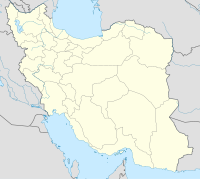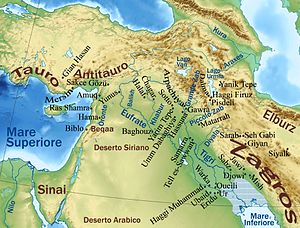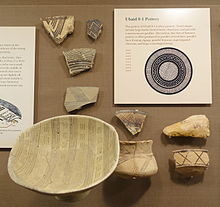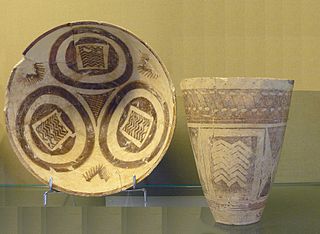204:
375:
147:
17:
362:
with coarse grit. One of these types is characterized by a grey-black burnished surface mostly with contrasting colours in the interior and exterior of the vessels. This type of coarse ware was used for producing bowls entirely. Conical bowls decorated with incised and excised designs are common; the incised designs are occasionally filled with a whitish paste. The second type of coarse ware is lighter in colour, often tan or pinkish buff. The surface of the vessels is either burnished or plain. Besides bowls there are jars with protruding rims and concave or recessed necks.
245:
43:
265:
50:
273:
well-preserved and contained many artefacts, but objects made of the precious metal were lacking. The archaeological evidence support the idea the settlement was abandoned quickly, but in an orderly manner. Just prior to that, in the final phases of Level VI a large architectural feature dubbed the "Oval
Enclosure" was uncovered.
657:
V. R. Badler, A Chronology of Uruk
Artifacts from Godin Tepe in Central Western Iran and Implications for the Interrelationships between the Local and Foreign Cultures." In Artefacts of Complexity: Tracking the Uruk in the Near East, edited by J. N. Postgate, pp. 79-109. Iraq Archaeological Reports
365:
The second group of
Transcaucasian Pottery found at Godin Tepe was classified as Common Ware. The fabric of this group was tempered by medium-fine grit and was not well-fired. This group of pottery has the same colour range like the coarse ware. The surfaces are highly burnished though the vessels
361:
The only notable architectural remains of this period consist of a number of plastered hearths. T. Cuyler Young Jr. defined three main groups of pottery for Level IV. Two of these groups belong to
Transcaucasian Early Bronze Age Culture. One of these groups bears two types of coarse ware tempered
272:
During the 1973 campaign, level V was excavated through a deep cut from the citadel. It was occupied during the period 3200–3000 BC. At the end of level V there was a clear gap in the settlement sequence. There were signs of fire, such as room 22 whose roof was burned. The houses were in general
235:
Thus, the importance of Godin Tepe may have been due to its position serving the early trade from the east, from as far as
Afghanistan, and to the Mesopotamian flood plain. For example, lapis-lazuli was brought from Badakhshan in Afghanistan to Mesopotamia.
540:
Because Godin was such a deep site and it was clear it was difficult to reach these early levels in 1971 and 1973 the Godin
Project conducted excavations at Seh Gabi, a Neolithic to Chalcolithic site some six kilometers northeast of Godin in the Kangavar
366:
with a light interior and dark exterior are predominant. The forms consist entirely of cups, including the recessed neck types. The decoration is similar in style and technique to the previous coarse wares, but the excised designs are less common.
321:
At level V 38 clay tablets of the "numerical tablets" or "impressed tablets" type from the Uruk V period (c. 3500-3350 BC) were found of which 27 were preserved in one piece. They contained primarily accounts, like those discovered at contemporary
158:
Because Godin has such a deep stratigraphy, it was decided that a related site of Seh Gabi nearby should also be studied. Seh Gabi is located 6 km northeast of Godin Tepe in the
Kangavar valley. The deeper levels were easier to reach there.
934:, Was There Ever a Median Empire?, pp. 197–212 in Method and Theory. Proceedings of the London 1985 Achaemenid History Workshop. (Achaemenid History III) A. Kuhrt, H. Sancisi-Weerdenburg (eds.), Leiden (1988,
219:. According to Mitchell Rothman, at this time, during the Late Chalcolithic 1 period (LC 1), some substantial trading networks emerged in the area for trade in metals, and in precious or semi-precious stones,
162:
Originally, the excavations at Godin concentrated on levels II (ended c. 500 BC?) to V (c. 3200 BC–3000 BC), but the transition from the
Neolithic to Chalcolithic was studied primarily at Seh Gabi.
310:
were found at level V. They were obviously produced locally, as shown by the discovery of an uncarved cylinder. The seal impressions show a parallel with Uruk, Susa and other sites in
1160:
1155:
1150:
639:
Desset, F. “AN ARCHITECTURAL PATTERN IN LATE FOURTH-MILLENNIUM BC WESTERN IRAN: A NEW LINK BETWEEN SUSA, TAL-I MALYAN, AND GODIN TEPE.” Iran, vol. 52, 2014, pp. 1–18
1180:
922:
Steve
Renette, Painted Pottery from Al-Hiba: Godin Tepe III Chronology and Interactions between Ancient Lagash and Elam, Iran, vol. 53, iss. 1, pp. 49–63, 2015
1065:
Matthews, R. 2013. "The power of writing: an administrative activity at Godin Tepe, Central Zagros, in the late fourth millennium BC", in C. Petrie (ed.),
574:
Henrickson, Elizabeth, 1989, Ceramic
Evidence for Cultural Interaction between the ‘Ubaid Tradition and the Central Zagros Highlands, Western Iran. In:
901:
Robert Carl Henrickson, Godin Tepe, Godin III, and Central Western Iran: C. 2600–1500 BC, University of Toronto dissertation, 1984 (PDF available at
648:
HilaryGopnik, A view from the east: The Godin VI Oval and the Uruk Sphere, Journal of Archaeological Science: Reports, vol. 7, pp. 835-848, June 2016
394:
has been established which may affect the chronology of this layer. Near 1400 BC, Godin Tepe was abandoned and was not re-occupied until c. 750 BC.
1106:
986:
T. Cuyler Young Jr and Louis D. Levine, "Excavations at Godin Tepe. Second Progress Report", Royal Ontario Museum Occasional Paper 26, 1974,
188:
350:
Level IV (3000–2650 BC) represents the "invasion" of the northern Yanik-culture (or "Transcaucasian Early Bronze I culture", also known as
1028:
Stuart Brown: "Media in the Achaemenid Period: The Late Iron Age in Central West Iran", in Heleen Sancisi-Weerdenburg & Amelie Kuhrt,
482:
Discovered in 1961, the site was excavated from 1965 to 1973 by a Canadian expedition headed by T. Cuyler Young Jr. and sponsored by the
913:
Robert C. Henrickson, A Regional Perspective on Godin III Cultural Development in Central Western Iran, Iran, vol. 24, pp. 1-55, 1986
223:"During the time of Godin VIII, the LC 1, a real increase in the movement of these goods is evident across the region. For example,
257:
1175:
1165:
208:
1011:
Harvey Weiss and T. Cuyler Young Jr, "Merchants of Susa: Godin V and plateau-lowland relations in the late Fourth Millennium BC",
1004:
299:
Cuyler-Young suggested the existence of Elamite trading posts at the site during this period, established by merchants from Susa.
203:
499:
1062:
Robert B. Mason and Lisa Cooper, Grog, "Petrology, and Early Transcaucasians at Godin Tepe", Iran, vol. 37, pp. 25–31, 1999
408:
Level II is represented by a single structure, a fortified, mud brick walled architectural complex (133 m x 55 m) occupied by a
872:
T. Cuyler Young Jr., "The Chronology of the Late Third and Second Millennia in Central Western Iran as Seen from Godin Tepe",
1170:
939:
719:
358:. (Nevertheless, some other Kura-Araxes potsherds were found in yet deeper layers going back to late fourth millennium BC.)
74:
126:. The importance of the site may have been due to its role as a trading outpost in the early Mesopotamian trade networks.
181:) (Godin XI/X) is very similar to the pottery traditions from the highlands north of Godin, especially from the area of
955:
533:
977:
T. Cuyler Young Jr, "Excavations at Godin Tepe. First Progress Report", Royal Ontario Museum Occasional Paper 17, 1969
885:
Sagona, A.G.; The Caucasian Region in the Early Bronze Age Part I–III, BAR International Series 214(i), Oxford, 1984.
1057:
991:
890:
743:
146:
618:
553:
520:
374:
1200:
446:
Godin was again abandoned during the 6th century BC, perhaps as a result or in anticipation of the expansion of
690:
678:
628:
563:
134:
The earliest evidence for occupation at Godin comes from Periods XI through VII, spanning the Early and Middle
950:
Hilary Gopnik and Mitchell S. Rothman, "On the High Road: The History of Godin Tepe", Iran, Mazda Pub, 2011,
587:
Hanan Bahranipoor 2023, NEW RADIOCARBON DATES FOR THE MIDDLE CHALCOLITHIC PERIOD OF THE CENTRAL ZAGROS, IRAN.
599:
1185:
1145:
1098:
42:
16:
1079:
V. R. Badler, "The Dregs of Civilization: 5000 Year-Old Wine and Beer: Residues from Godin Tepe, Iran",
1067:
Ancient Iran and its Neighbours: Local Developments and Long-Range Interactions in the 4th Millennium BC
931:
1069:, British Institute of Persian Studies, Archaeological Monographs Series, Oxbow Books, Oxford: 337–351
231:
area of northeastern Afghanistan, began to appear in LC1 sites in significant amounts (Herman 1968)."
334:
Traces of wine and beer found in ceramics dated to c. 3100–2900 BC and along with the findings at
351:
339:
1041:
1190:
711:
296:
tall storage jars, known from Nippur, and the bevelled rim bowls of Uruk are missing however.
1195:
668:
451:
703:
440:
338:, provide evidence of the early production of those beverages in the Zagros Mountains. Some
1205:
827:
768:
483:
8:
1072:
Lesley Frame, Metallurgical investigations at Godin Tepe, Iran, Part I: the metal finds,
244:
123:
111:
831:
772:
1093:
1002:
966:
902:
850:
815:
791:
756:
1053:
987:
951:
935:
886:
855:
796:
739:
715:
704:
674:
624:
559:
529:
416:
403:
191:(Nad Ali Beig) is another prehistoric site located to the northwest of Godin in this
578:
Edited by E. Henrickson and I. Thuesen. 368–403. Copenhagen: Museum Tusculanum Press
845:
835:
786:
776:
335:
1008:
455:
447:
303:
1036:
623:
Chapter 4. Contact and Development in Godin Period VI. Mazda Publishers, 2011
558:
Chapter 4. Contact and Development in Godin Period VI. Mazda Publishers, 2011
1139:
1121:
1108:
816:"Early Bronze Age migrants and ethnicity in the Middle Eastern mountain zone"
757:"Early Bronze Age migrants and ethnicity in the Middle Eastern mountain zone"
307:
174:
170:
89:
76:
1099:
Beer & Bullets to Go: Ancient 'Takeout' Window Discovered - Live Science
840:
781:
670:
Cross-Cultural Trade in World History: Studies in Comparative World History.
165:
The earliest pottery found was of the painted pottery traditions, including
859:
800:
412:
277:
253:
224:
216:
151:
135:
606:
415:. The columned halls are in the same architectural tradition of the later
382:
Level III (c. 2600–1500/1400 BC) shows connections with Susa and most of
323:
293:
692:
Hallo, William W., "Godin Tepe: The Inscriptions", Yale University, 2011
20:
Ceramic bowl with painted decoration from Godin Tepe, Iran; 1450–1150 BC
424:
420:
355:
228:
182:
178:
588:
378:
Vessel with painted decoration from Godin Tepe, Iran. Ca. 1450–1150 BC
432:
311:
318:
served as raw material for these, sometimes treated with tempering.
436:
383:
315:
192:
119:
227:, a semi-precious blue stone known to occur naturally only in the
487:
459:
428:
387:
471:
391:
342:
potsherds also seem to appear in association with wine making.
289:
154:. Seh Gabi on the right also marks the location of Godin Tepe.
522:
On the High Road: The History of Godin Tepe, Iran (Chapter 2)
409:
264:
215:
Level VIII is dated 4200–4000 BC, contemporary with Terminal
285:
281:
249:
115:
450:(c. 550 BC) (Brown 1990) or due to the interruption of a
443:(I), Jameh Shuran (IIa), Tepe Nush-i Jan and Pasargadae.
138:. The site was already inhabited as early as c. 5200 BC.
1161:
Populated places disestablished in the 1st millennium BC
1156:
Populated places disestablished in the 6th century BC
1151:
Populated places established in the 6th millennium BC
386:, and it has been suggested that it belonged to the
620:On the High Road: The History of Godin Tepe, Iran.
555:On the High Road: The History of Godin Tepe, Iran.
1081:Bulletin of the Canadian Society for Mesopotamian
1050:On the High Road: The History of Godin Tepe, Iran
1137:
276:The pottery of level V show influences from the
1181:Buildings and structures in Kermanshah province
820:Proceedings of the National Academy of Sciences
761:Proceedings of the National Academy of Sciences
728:
604:Defining Dalma: an Incipient Mountain Identity?
519:Rothman, Mitchell S.; Badler, Virginia (2011).
326:sites in western Iran, Syria, and Mesopotamia.
314:. They were partly decorated with drill holes.
658:5, British School of Archaeology in Iraq, 2002
576:Upon This Foundation: the ‘Ubaid Reconsidered.
268:Archaeological plan of Godin Tepe V settlement
518:
150:Important sites in the Near East during the
1030:Achaemenid History IV: Centre and Periphery
431:(V). The Level II pottery (only wheel-made
354:), well known from Yanik Tepe, Iran, near
849:
839:
790:
780:
617:Mitchell S. Rothman and Virginia Badler,
552:Mitchell S. Rothman and Virginia Badler,
1076:, vol. 37, Iss. 7, Pages 1700–1715, 2010
373:
263:
243:
207:Ubaid pottery (Ubaid 0-1 levels) at the
202:
145:
15:
1048:Hilary Gopnik and Mitchell S. Rothman,
813:
754:
607:https://doi.org/10.4000/paleorient.1699
500:List of cities of the ancient Near East
1138:
968:H.Gopnik Godin Tepe TSpace Web Archive
876:vol. 73, no. 3, pp. 287–291, 1969
701:
435:buff ware) have strong parallels with
195:area. It also features Dalma pottery.
600:Regional map of archaeological sites.
706:Drink: A Cultural History of Alcohol
458:formation process after the fall of
329:
589:https://doi.org/10.1017/RDC.2023.41
404:Archeology of Iran in Median period
13:
710:. New York: Gotham Books. p.
49:
14:
1217:
1087:
1074:Journal of Archaeological Science
673:Cambridge University Press, 1984
390:confederacy. A pottery link to
48:
41:
1176:Former populated places in Iran
1166:1961 archaeological discoveries
996:
980:
971:
960:
944:
925:
916:
907:
895:
879:
874:American Journal of Archaeology
866:
807:
748:
695:
684:
661:
528:. Mazda Publishers. p. 2.
1094:Godin Tepe TSpace Web Archive
1083:, vol 35, pp. 48–56, 2000
651:
642:
633:
611:
593:
581:
568:
546:
512:
477:
1:
1022:
814:Rothman, Mitchell S. (2015).
755:Rothman, Mitchell S. (2015).
258:Sèvres – Cité de la céramique
239:
198:
1171:Archaeological sites in Iran
369:
7:
904:Tspace.library.utoronto.ca)
738:pg 2-3 Harper Collins 2000
493:
397:
345:
248:Goblet and cup, Iran, from
141:
118:, located in the valley of
10:
1222:
932:Heleen Sancisi-Weerdenburg
465:
401:
256:; goblet height c. 12 cm;
169:(Godin pre-XI) related to
129:
1015:, vol. 13, pp. 1–17, 1975
209:Oriental Institute Museum
70:
36:
29:
505:
841:10.1073/pnas.1502220112
782:10.1073/pnas.1502220112
736:A Short History of Wine
602:in Steve Renette 2022,
427:), first documented at
173:pottery. The impressed
1201:National works of Iran
379:
269:
261:
252:, 4th millennium BC -
233:
212:
155:
21:
1035:T. Cuyler Young Jr.:
702:Gately, Iain (2009).
452:social stratification
377:
267:
247:
221:
206:
149:
90:34.51667°N 48.06667°E
19:
1042:Encyclopædia Iranica
484:Royal Ontario Museum
280:, with parallels at
1186:Kura-Araxes culture
1146:Tells (archaeology)
1118: /
1052:, Mazda Pub, 2011,
832:2015PNAS..112.9190R
773:2015PNAS..112.9190R
474:(c. 15th century).
352:Kura–Araxes culture
340:Kura–Araxes culture
124:Kermanshah province
112:archaeological site
86: /
1007:2010-07-21 at the
667:Philip D. Curtin,
380:
270:
262:
213:
156:
95:34.51667; 48.06667
22:
1122:34.517°N 48.067°E
940:978-90-6258-403-1
826:(30): 9190–9195.
767:(30): 9190–9195.
721:978-1-592-40464-3
330:Early wine-making
105:
104:
1213:
1133:
1132:
1130:
1129:
1128:
1123:
1119:
1116:
1115:
1114:
1111:
1032:(1990), Leinden.
1016:
1000:
994:
984:
978:
975:
969:
964:
958:
948:
942:
929:
923:
920:
914:
911:
905:
899:
893:
883:
877:
870:
864:
863:
853:
843:
811:
805:
804:
794:
784:
752:
746:
732:
726:
725:
709:
699:
693:
688:
682:
665:
659:
655:
649:
646:
640:
637:
631:
615:
609:
597:
591:
585:
579:
572:
566:
550:
544:
543:
527:
516:
470:A late, Islamic
336:Hajji Firuz Tepe
101:
100:
98:
97:
96:
91:
87:
84:
83:
82:
79:
62:Location in Iran
52:
51:
45:
27:
26:
1221:
1220:
1216:
1215:
1214:
1212:
1211:
1210:
1136:
1135:
1126:
1124:
1120:
1117:
1112:
1109:
1107:
1105:
1104:
1090:
1025:
1020:
1019:
1009:Wayback Machine
1001:
997:
985:
981:
976:
972:
965:
961:
949:
945:
930:
926:
921:
917:
912:
908:
900:
896:
884:
880:
871:
867:
812:
808:
753:
749:
733:
729:
722:
700:
696:
689:
685:
666:
662:
656:
652:
647:
643:
638:
634:
616:
612:
598:
594:
586:
582:
573:
569:
551:
547:
536:
525:
517:
513:
508:
496:
480:
468:
448:Cyrus the Great
406:
400:
372:
348:
332:
242:
201:
144:
132:
94:
92:
88:
85:
80:
77:
75:
73:
72:
66:
65:
64:
63:
60:
59:
58:
57:
53:
32:
25:
12:
11:
5:
1219:
1209:
1208:
1203:
1198:
1193:
1188:
1183:
1178:
1173:
1168:
1163:
1158:
1153:
1148:
1127:34.517; 48.067
1102:
1101:
1096:
1089:
1088:External links
1086:
1085:
1084:
1077:
1070:
1063:
1060:
1046:
1033:
1024:
1021:
1018:
1017:
995:
979:
970:
959:
956:978-1568591650
943:
924:
915:
906:
894:
878:
865:
806:
747:
727:
720:
694:
683:
660:
650:
641:
632:
610:
592:
580:
567:
545:
535:978-1568591650
534:
510:
509:
507:
504:
503:
502:
495:
492:
479:
476:
467:
464:
454:and secondary
399:
396:
371:
368:
347:
344:
331:
328:
308:cylinder seals
302:Thirteen seal
241:
238:
200:
197:
143:
140:
131:
128:
103:
102:
68:
67:
61:
55:
54:
47:
46:
40:
39:
38:
37:
34:
33:
30:
23:
9:
6:
4:
3:
2:
1218:
1207:
1204:
1202:
1199:
1197:
1194:
1192:
1191:Halaf culture
1189:
1187:
1184:
1182:
1179:
1177:
1174:
1172:
1169:
1167:
1164:
1162:
1159:
1157:
1154:
1152:
1149:
1147:
1144:
1143:
1141:
1134:
1131:
1100:
1097:
1095:
1092:
1091:
1082:
1078:
1075:
1071:
1068:
1064:
1061:
1059:
1058:1-56859-165-9
1055:
1051:
1047:
1044:
1043:
1038:
1034:
1031:
1027:
1026:
1014:
1010:
1006:
1003:
999:
993:
992:0-88854-019-1
989:
983:
974:
967:
963:
957:
953:
947:
941:
937:
933:
928:
919:
910:
903:
898:
892:
891:0-86054-277-7
888:
882:
875:
869:
861:
857:
852:
847:
842:
837:
833:
829:
825:
821:
817:
810:
802:
798:
793:
788:
783:
778:
774:
770:
766:
762:
758:
751:
745:
744:0-06-621282-0
741:
737:
731:
723:
717:
713:
708:
707:
698:
691:
687:
680:
676:
672:
671:
664:
654:
645:
636:
630:
626:
622:
621:
614:
608:
605:
601:
596:
590:
584:
577:
571:
565:
561:
557:
556:
549:
542:
537:
531:
524:
523:
515:
511:
501:
498:
497:
491:
489:
485:
475:
473:
463:
461:
457:
453:
449:
444:
442:
441:Bābā Jān Tepe
438:
434:
430:
426:
422:
418:
414:
411:
405:
395:
393:
389:
385:
376:
367:
363:
359:
357:
353:
343:
341:
337:
327:
325:
319:
317:
313:
309:
305:
300:
297:
295:
291:
287:
283:
279:
274:
266:
259:
255:
251:
246:
237:
232:
230:
226:
220:
218:
210:
205:
196:
194:
190:
186:
184:
180:
176:
172:
171:Halaf culture
168:
163:
160:
153:
148:
139:
137:
127:
125:
121:
117:
113:
109:
99:
71:Coordinates:
69:
44:
35:
28:
18:
1196:Ubaid period
1103:
1080:
1073:
1066:
1049:
1040:
1037:"Godin Tepe"
1029:
1012:
998:
982:
973:
962:
946:
927:
918:
909:
897:
881:
873:
868:
823:
819:
809:
764:
760:
750:
735:
734:R. Phillips
730:
705:
697:
686:
669:
663:
653:
644:
635:
619:
613:
603:
595:
583:
575:
570:
554:
548:
539:
521:
514:
481:
469:
445:
407:
381:
364:
360:
349:
333:
320:
301:
298:
292:The typical
278:Uruk culture
275:
271:
254:Ubaid period
234:
225:lapis lazuli
222:
217:Ubaid period
214:
187:
166:
164:
161:
157:
152:Ubaid period
136:Chalcolithic
133:
107:
106:
1206:Uruk period
1125: /
490:, Canada).
478:Excavations
324:Uruk period
304:impressions
294:Jemdet Nasr
189:Nadali Beig
114:in western
93: /
1140:Categories
1023:References
679:0521269318
629:1568591659
564:1568591659
425:Persepolis
421:Pasargadae
402:See also:
356:Lake Urmia
240:Level VI/V
199:Level VIII
183:Lake Urmia
179:Dalma Tepe
175:Dalma ware
108:Godin Tepe
81:48°04′00″E
78:34°31′00″N
56:Godin Tepe
31:Godin Tepe
439:sites as
433:micaceous
370:Level III
312:Khuzestan
288:(IV) and
229:Badakshan
211:, Chicago
1005:Archived
860:26080417
801:26080417
494:See also
437:Iron Age
423:, Susa,
398:Level II
384:Luristan
346:Level IV
316:Steatite
306:and two
260:, France
193:Kangavar
142:Seh Gabi
120:Kangavar
1113:48°04′E
1110:34°31′N
851:4522795
828:Bibcode
792:4522795
769:Bibcode
541:valley.
488:Toronto
466:Level I
460:Assyria
429:Hasanlu
419:halls (
417:Persian
388:Elamite
130:History
1056:
990:
954:
938:
889:
858:
848:
799:
789:
742:
718:
677:
627:
562:
532:
472:shrine
392:Lagash
290:Nippur
167:J ware
110:is an
1039:, in
526:(PDF)
506:Notes
456:State
413:chief
24:Place
1054:ISBN
1013:Iran
988:ISBN
952:ISBN
936:ISBN
887:ISBN
856:PMID
797:PMID
740:ISBN
716:ISBN
675:ISBN
625:ISBN
560:ISBN
530:ISBN
410:Mede
286:Uruk
282:Susa
250:Susa
116:Iran
846:PMC
836:doi
824:112
787:PMC
777:doi
765:112
681:p65
122:in
1142::
854:.
844:.
834:.
822:.
818:.
795:.
785:.
775:.
763:.
759:.
714:.
538:.
462:.
284:,
185:.
1045:.
862:.
838::
830::
803:.
779::
771::
724:.
712:3
486:(
177:(
Text is available under the Creative Commons Attribution-ShareAlike License. Additional terms may apply.





